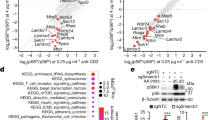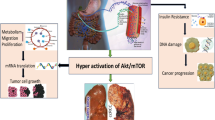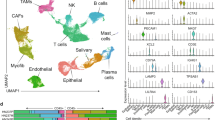Abstract
SGK1 is an AGC kinase that regulates the expression of membrane sodium channels in renal tubular cells in a manner dependent on the metabolic checkpoint kinase complex mTORC2. We hypothesized that SGK1 might represent an additional mTORC2-dependent regulator of the differentiation and function of T cells. Here we found that after activation by mTORC2, SGK1 promoted T helper type 2 (TH2) differentiation by negatively regulating degradation of the transcription factor JunB mediated by the E3 ligase Nedd4-2. Simultaneously, SGK1 repressed the production of interferon-γ (IFN-γ) by controlling expression of the long isoform of the transcription factor TCF-1. Consistent with those findings, mice with selective deletion of SGK1 in T cells were resistant to experimentally induced asthma, generated substantial IFN-γ in response to viral infection and more readily rejected tumors.
This is a preview of subscription content, access via your institution
Access options
Subscribe to this journal
Receive 12 print issues and online access
$259.00 per year
only $21.58 per issue
Buy this article
- Purchase on SpringerLink
- Instant access to full article PDF
Prices may be subject to local taxes which are calculated during checkout







Similar content being viewed by others
References
Pearce, L.R., Komander, D. & Alessi, D.R. The nuts and bolts of AGC protein kinases. Nat. Rev. Mol. Cell. Biol. 11, 9–22 (2010).
Biondi, R.M., Kieloch, A., Currie, R.A., Deak, M. & Alessi, D.R. The PIF-binding pocket in PDK1 is essential for activation of S6K and SGK, but not PKB. EMBO J. 20, 4380–4390 (2001).
Garcia-Martinez, J.M. & Alessi, D.R. mTOR complex 2 (mTORC2) controls hydrophobic motif phosphorylation and activation of serum- and glucocorticoid-induced protein kinase 1 (SGK1). Biochem. J. 416, 375–385 (2008).
Yan, L., Mieulet, V. & Lamb, R.F. mTORC2 is the hydrophobic motif kinase for SGK1. Biochem. J. 416, e19–e21 (2008).
Debonneville, C. et al. Phosphorylation of Nedd4–2 by Sgk1 regulates epithelial Na+ channel cell surface expression. EMBO J. 20, 7052–7059 (2001).
Ichimura, T. et al. 14–3-3 proteins modulate the expression of epithelial Na+ channels by phosphorylation-dependent interaction with Nedd4–2 ubiquitin ligase. J. Biol. Chem. 280, 13187–13194 (2005).
Di Pietro, N. et al. Serum- and glucocorticoid-inducible kinase 1 (SGK1) regulates adipocyte differentiation via forkhead box O1. Mol. Endocrinol. 24, 370–380 (2010).
Brunet, A. et al. Protein kinase SGK mediates survival signals by phosphorylating the forkhead transcription factor FKHRL1 (FOXO3a). Mol. Cell. Biol. 21, 952–965 (2001).
Sakoda, H. et al. Differing roles of Akt and serum- and glucocorticoid-regulated kinase in glucose metabolism, DNA synthesis, and oncogenic activity. J. Biol. Chem. 278, 25802–25807 (2003).
Wiemuth, D. et al. Interaction of serum- and glucocorticoid regulated kinase 1 (SGK1) with the WW-domains of Nedd4–2 is required for epithelial sodium channel regulation. PLoS One 5, e12163 (2010).
Fejes-Toth, G., Frindt, G., Naray-Fejes-Toth, A. & Palmer, L.G. Epithelial Na+ channel activation and processing in mice lacking SGK1. Am. J. Physiol. Renal Physiol. 294, F1298–F1305 (2008).
Wu, C. et al. Induction of pathogenic T17 cells by inducible salt-sensing kinase SGK1. Nature 496, 513–517 (2013).
Kleinewietfeld, M. et al. Sodium chloride drives autoimmune disease by the induction of pathogenic T17 cells. Nature 496, 518–522 (2013).
Zoncu, R., Efeyan, A. & Sabatini, D.M. mTOR: from growth signal integration to cancer, diabetes and ageing. Nat. Rev. Mol. Cell. Biol. 12, 21–35 (2011).
Powell, J.D., Pollizzi, K.N., Heikamp, E.B. & Horton, M.R. Regulation of immune responses by mTOR. Annu. Rev. Immunol. 30, 39–68 (2012).
Delgoffe, G.M. et al. The mTOR kinase differentially regulates effector and regulatory T cell lineage commitment. Immunity 30, 832–844 (2009).
Zhang, S. et al. Constitutive reductions in mTOR alter cell size, immune cell development, and antibody production. Blood 117, 1228–1238 (2011).
Delgoffe, G.M. et al. The kinase mTOR regulates the differentiation of helper T cells through the selective activation of signaling by mTORC1 and mTORC2. Nat. Immunol. 12, 295–303 (2011).
Lee, K. et al. Mammalian target of rapamycin protein complex 2 regulates differentiation of Th1 and Th2 cell subsets via distinct signaling pathways. Immunity 32, 743–753 (2010).
Murray, J.T. et al. Exploitation of KESTREL to identify NDRG family members as physiological substrates for SGK1 and GSK3. Biochem. J. 384, 477–488 (2004).
Lu, M., Wang, J., Ives, H.E. & Pearce, D. mSIN1 protein mediates SGK1 protein interaction with mTORC2 protein complex and is required for selective activation of the epithelial sodium channel. J. Biol. Chem. 286, 30647–30654 (2011).
Feldman, M.E. et al. Active-site inhibitors of mTOR target rapamycin-resistant outputs of mTORC1 and mTORC2. PLoS Biol 7, e38 (2009).
Sarbassov, D.D., Guertin, D.A., Ali, S.M. & Sabatini, D.M. Phosphorylation and regulation of Akt/PKB by the rictor-mTOR complex. Science 307, 1098–1101 (2005).
Guertin, D.A. et al. Ablation in mice of the mTORC components raptor, rictor, or mLST8 reveals that mTORC2 is required for signaling to Akt-FOXO and PKCalpha, but not S6K1. Dev. Cell 11, 859–871 (2006).
Jacinto, E. et al. SIN1/MIP1 maintains rictor-mTOR complex integrity and regulates Akt phosphorylation and substrate specificity. Cell 127, 125–137 (2006).
Oliver, P.M. et al. Ndfip1 protein promotes the function of itch ubiquitin ligase to prevent T cell activation and T helper 2 cell-mediated inflammation. Immunity 25, 929–940 (2006).
Fang, D. et al. Dysregulation of T lymphocyte function in itchy mice: a role for Itch in TH2 differentiation. Nat. Immunol. 3, 281–287 (2002).
Li, B., Tournier, C., Davis, R.J. & Flavell, R.A. Regulation of IL-4 expression by the transcription factor JunB during T helper cell differentiation. EMBO J. 18, 420–432 (1999).
Huang, T.J. et al. Allergen-specific Th1 cells counteract efferent Th2 cell-dependent bronchial hyperresponsiveness and eosinophilic inflammation partly via IFN-γ. J. Immunol. 166, 207–217 (2001).
Liu, C. et al. Control of beta-catenin phosphorylation/degradation by a dual-kinase mechanism. Cell 108, 837–847 (2002).
Yu, Q., Sharma, A. & Sen, J.M. TCF1 and β-catenin regulate T cell development and function. Immunol. Res. 47, 45–55 (2010).
Yu, Q. et al. T cell factor 1 initiates the T helper type 2 fate by inducing the transcription factor GATA-3 and repressing interferon-γ. Nat. Immunol. 10, 992–999 (2009).
Roose, J. et al. Synergy between tumor suppressor APC and the β-catenin-Tcf4 target Tcf1. Science 285, 1923–1926 (1999).
Quezada, S.A. et al. Tumor-reactive CD4+ T cells develop cytotoxic activity and eradicate large established melanoma after transfer into lymphopenic hosts. J. Exp. Med. 207, 637–650 (2010).
Suissa, S., Ernst, P., Benayoun, S., Baltzan, M. & Cai, B. Low-dose inhaled corticosteroids and the prevention of death from asthma. N. Engl. J. Med. 343, 332–336 (2000).
Fanta, C.H. Asthma. N. Engl. J. Med. 360, 1002–1014 (2009).
Littenberg, B. & Gluck, E.H. A controlled trial of methylprednisolone in the emergency treatment of acute asthma. N. Engl. J. Med. 314, 150–152 (1986).
Sherk, A.B. et al. Development of a small-molecule serum- and glucocorticoid-regulated kinase-1 antagonist and its evaluation as a prostate cancer therapeutic. Cancer Res. 68, 7475–7483 (2008).
Ackermann, T.F. et al. EMD638683, a novel SGK inhibitor with antihypertensive potency. Cell Physiol. Biochem. 28, 137–146 (2011).
Kumar, A. et al. Muscle-specific deletion of rictor impairs insulin-stimulated glucose transport and enhances Basal glycogen synthase activity. Mol. Cell Biol. 28, 61–70 (2008).
Daan de Boer, J. et al. Lipopolysaccharide inhibits Th2 lung inflammation induced by house dust mite allergens in mice. Am. J. Respir. Cell. Mol. Biol. 48, 382–389 (2013).
Acknowledgements
We thank D. Pardoll, C. Gamper and members of the Powell Lab for discussions, and the Magnuson laboratory for Rictor−/− mice. Supported by the US National Institutes of Health (R01 AI77610 to J.D.P., NHLBI P01HL010342 and NHLBI R21HL111783 to M.R.H., DK 41481 to A.N.-F.-T. and DK 58898 to G.F.-T.), the American Asthma Foundation (J.D.P.), the Intramural Research Program of the NIH, National Institute on Aging (J.M.S.), the FAMRI Center of Excellence 108595 (M.R.H.) and the American Medical Association (E.B.H.).
Author information
Authors and Affiliations
Contributions
E.B.H. helped design and do experiments and write the paper; C.H.P., S.C., M.-H.O. and I.-H.S. assisted in the in vivo experiments and biochemistry; A.W. contributed to the design of experiments and interpretation of data; P.I. assigned scores to the lung histology; A.S. and J.M.-S. constructed the plasmid encoding TCF1 and helped with analysis of TCF1; A.N.-F.-T. and G.F.-T. generated the Sgk1fl/fl mice; M.R.H. helped design the lung experiments and contributed to the writing of the paper; and J.D.P. conceived of the project and helped design the experiments and write the paper.
Corresponding author
Ethics declarations
Competing interests
The authors declare no competing financial interests.
Integrated supplementary information
Supplementary Figure 1 Sgk1 mRNA is expressed in CD4+ and CD8+ T cells and is upregulated in response to cytokines.
(a) CD4+ and CD8+ T cells were isolated from wild-type and T-Sgk1-/- mice by magnetic separation, and RNA was isolated. Sgk1 mRNA levels were determined by polymerase chain reaction using the following excision primers: forward primer 5-CTCAGTCTCTTTTGGGCTCTTT-3 and the reverse primer 5-TTTCTTCTTCAGGATGGCTTTC-3, as described in the Methods. GAPDH is included as a loading control. Data is representative of 3 independent experiments. (b) CD4+ T cells were isolated from 5C.C7 mice using magnetic separation, and cells were stimulated with anti-CD3 and anti-CD28 for 1 hour under polarizing conditions. RNA was isolated and reverse transcribed into cDNA to measure expression of Sgk1 by RT-PCR. Expression is normalized to the unstimulated control and to 18s rRNA expression
Supplementary Figure 2 mTORC2 is required for activation of SGK1.
(a) Model depicting downstream targets of mTORC2. Activation of mTORC2 leads to phosphorylation of Akt (p-S473) and SGK1 (p-S422). Activation of SGK1 leads to phosphorylation of its downstream target NDRG1 (p-T346). (b) ImageJ software was used to calculate band density from 3 independent experiments shown in Fig. 2a, and band density was normalized to loading controls and to WT unstimulated (US) conditions. (c) Flow cytometric analysis of CD4+ T cells isolated from WT, T-Rictor-/-, and T-Sgk1-/- mice and stimulated with anti-CD3 and anti-CD28 for 1,3, or 6 hours. Cells were permeabilised with methanol and interrogated for phosphorylation of Akt (S473) using flow cytometry. Numbers in upper right corner of each plot indicate mean fluorescent index (MFI) of p-Akt or total Akt. Below, MFI of p-Akt from flow cytometry plots above were normalized to the MFI of total Akt. Data are representative of 3 independent experiments (a-c), statistical significance calculated by ANOVA, ns=no significance, error bars s.e.m.)
Supplementary Figure 3 Characterization of lymphocyte development and maturation of T-Sgk1-/- mice.
(a) Flow cytometric phenotyping data compiled from multiple mice (n=6) of double negative (CD4-CD8-), double positive (CD4+CD8+), or single positive (CD4+ or CD8+) thymocytes, (b,c) absolute numbers of B220+, CD3+, CD4+, and CD8+ cells in the spleen and lymph nodes, (d-g) expression of CD44 and CD62L on both CD4+ and CD8+ subsets in the spleen and lymph nodes, (h) expression of Treg phenotypic markers (CD3+ CD4+ CD25+ FoxP3+) in spleen and lymph nodes. Data are compiled from 6 mice and are representative of 3 independent experiments. Statistical significance determined by Student's t-test, NS=No Significance, *P<0.05 **P<0.01, error bars s.e.m.
Supplementary Figure 4 SGK1 is not required for TH17 differentiation in vitro.
Intracellular staining of CD4+ T cells that were polarized for 48 hours under TH0 or TH17 (IL-6 and TGF-β) conditions, then rested and restimulated as in Fig. 3D. Data is representative of 3 independent experiments.
Supplementary Figure 5 Knockdown of Nedd4-2 and Ndfip by siRNA.
Quantitative PCR analysis of NEDD4-2 (a) and Ndfip (b) mRNA in CD4+ T cells from WT and T-Sgk1-/- mice. RNA was harvested from cells 24 hours after transfection with siRNA for analysis by real time PCR. Gene expression is normalized to 18s rRNA and to the WT scrambled control. Data is representative of two independent experiments, and samples were analyzed in triplicate for each experiment. Statistical significance calculated by ANOVA, *P<0.001, error bars s.e.m.)
Supplementary Figure 6 Diminished TH2 cell–mediated immunity in vivo in T-Sgk1-/- mice in asthma models.
(a) IL-4 production in bronchoalveolar lavage (BAL) harvested from mice that had been sensitized with OVA in alum i.p., then rechallenged with intranasal OVA on days 15, 16, and 17, followed by sacrifice on day 18. Lungs were lavaged with PBS and analyzed by ELISA. (b) Total IgE in serum. (c) OVA-specific IgG2a in serum. (d) IFN-γ production by lung lymphocytes, as measured by intracellular staining and flow cytometry. As in A, lung lymphocytes were harvested from diseased mice and stimulated for 4 hours ex vivo with PMA and ionomycin. (e) Analysis of CD4+ lymphocytes found in the lungs and mediastinal lymph nodes of mice that were sensitized and challenged with HDM extract as described in Fig 5. Graph depicts absolute number of CD4+ T cells recovered from each compartment. (f) BAL was analyzed by cytospin and Diff-quick staining for the presence of lymphocytes in WT and T-Sgk1-/- mice that were sensitized and challenged with HDM extract as described in Fig 5. Data are representative of 3 independent experiments, and n=5-11 mice per group, *P<0.05, **P<0.01, ***P<0.001. (Statistical significance calculated by ANOVA (d) or Student's t test, error bars s.e.m.)
Supplementary Figure 7 Model for the regulation of TCF-1 by SGK1.
In WT T cells, activation of mTORC2 downstream of TCR signaling results in activation of SGK1. In turn, SGK1 phosphorylates and inhibits GSK-3β. When GSK-3β is inactive, its target β-catenin cannot be degraded. Active β-catenin cooperates with the long isoforms of TCF-1 to promote transcription of TCF-1, which inhibits expression of IFN-γ. In T-Sgk1-/- cells, GSK-3β is active and thus targets β-catenin for destruction. Loss of β-catenin leads to decreased expression of TCF-1 long isoforms, and thus increased expression of IFN-γ.
Supplementary Figure 8 Diminished melanoma tumor burden in T-Sgk1-/- mice.
Representative images from one of 3 independent experiments showing reduced melanoma tumor burden in the lungs of T-Sgk1–/– mice as compared to WT mice.
Supplementary information
Supplementary Text and Figures
Supplementary Figures 1–8 (PDF 1145 kb)
Rights and permissions
About this article
Cite this article
Heikamp, E., Patel, C., Collins, S. et al. The AGC kinase SGK1 regulates TH1 and TH2 differentiation downstream of the mTORC2 complex. Nat Immunol 15, 457–464 (2014). https://doi.org/10.1038/ni.2867
Received:
Accepted:
Published:
Issue date:
DOI: https://doi.org/10.1038/ni.2867
This article is cited by
-
The regulation and differentiation of regulatory T cells and their dysfunction in autoimmune diseases
Nature Reviews Immunology (2024)
-
Estrogen-sensitive activation of SGK1 induces M2 macrophages with anti-inflammatory properties and a Th2 response at the maternal–fetal interface
Reproductive Biology and Endocrinology (2023)
-
Serum/glucocorticoid-inducible kinase 1 deficiency induces NLRP3 inflammasome activation and autoinflammation of macrophages in a murine endolymphatic hydrops model
Nature Communications (2023)
-
Role of Serum/Glucocorticoid-Regulated Kinase 1 (SGK1) in Immune and Inflammatory Diseases
Inflammation (2023)
-
PDCD5 inhibits progression of renal cell carcinoma by promoting T cell immunity: with the involvement of the HDAC3/microRNA-195-5p/SGK1
Clinical Epigenetics (2022)



